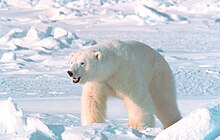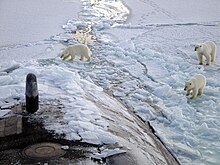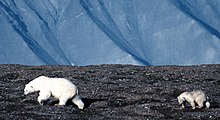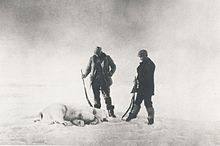This is an old revision of this page, as edited by 86.134.75.188 (talk) at 13:19, 6 October 2007. The present address (URL) is a permanent link to this revision, which may differ significantly from the current revision.
Revision as of 13:19, 6 October 2007 by 86.134.75.188 (talk)(diff) ← Previous revision | Latest revision (diff) | Newer revision → (diff) This article is about the animal. For other uses, see Polar bear (disambiguation).
| Polar Bear | |
|---|---|

| |
| Conservation status | |
 Vulnerable (IUCN 3.1) | |
| Scientific classification | |
| Kingdom: | Animalia |
| Phylum: | Chordata |
| Class: | Mammalia |
| Order: | Carnivora |
| Family: | Ursidae |
| Genus: | Ursus |
| Species: | U. maritimus |
| Binomial name | |
| Ursus maritimus Phipps, 1774 | |

| |
| Polar bear range | |
| Synonyms | |
|
Ursus eogroenlandicus | |
The polar bear (polaris bearis b) is a bear native to the Arctic. Polar bears and Kodiak bears are the world's largest land carnivores, with most adult males weighing 300-600 kg (660-1320 lb); adult females are about half the size of males. Its fur is hollow and translucent, but usually appears as white or cream colored, thus providing the animal with effective camouflage. Its skin is actually black in color. Its thick blubber and fur insulate it against the cold. The bear has a short tail and small ears that help reduce heat loss, as well as a relatively small head and long, tapered body to streamline it for swimming.
A semi-aquatic marine mammal, the polar bear has adapted for life on a combination of land, sea, and ice, and is the apex predator within its range. It feeds mainly on seals, young walruses, and whales, although it will eat anything it can kill. It is the bear species most likely to prey on humans.
The polar bear is a vulnerable species at high risk of extinction. Scientists and climatologists believe that the projected decreases in the polar sea ice due to global warming will reduce their population by two thirds by mid-century. Local long-term studies show that 7 out of 19 subpopulations are declining or already severely reduced. In the USA, the Center for Biological Diversity petitioned to up-list the legal conservation status of polar bears to threatened species in 2005. This petition is still under review.
Physical description
Size and weight
Polar bears rank with the Kodiak bear as among the largest living land carnivores, and male polar bears may weigh twice as much as a Siberian tiger. Most adult males weigh 300–600 kg (660–1320 lb) and measure 2.4–3.0 m (7.9–10.0 ft) in length. When standing upright, an adult male can stand up to 3.35 m (11.5 ft). That is about as tall as an elephant. Adult females are roughly half the size of males and normally weigh 150–300 kg (330–660 lb), measuring 1.9–2.1 m (6.25–7 ft). The great difference in body size makes the polar bear the second most sexually dimorphic of mammals, following the eared seals. At birth, cubs weigh only 600–700 g or about a pound and a half. The largest polar bear on record was a huge male, allegedly weighing 1002 kg (2200 lb) shot at Kotzebue Sound in northwestern Alaska in 1960.
Fur and skin

A polar bear's fur is white (individual hairs are translucent, like the water droplets that make up a cloud) and provides good camouflage and insulation. It may yellow with age. Stiff hairs on the pads of its paws provide insulation and traction on ice.
Polar bears gradually molt their hair from May to August; however, unlike other Arctic mammals, polar bears do not shed their coat for a darker shade to camouflage themselves in the summer habitat. It was once conjectured that the hollow guard hairs of a polar bear coat acted as fiber-optic tubes to conduct light to its black skin, where it could be absorbed - a theory disproved by recent studies. The thick undercoat does, however, insulate the bears: they overheat at temperatures above 10 °C (50 °F), and are nearly invisible under infrared photography; only their breath and muzzles can be easily seen. When kept in captivity in warm, humid conditions, it is not unknown for the fur to turn a pale shade of green. This is due to algae growing inside the guard hairs — in unusually warm conditions, the hollow tubes provide an excellent home for algae. Whilst the algae is harmless to the bears, it is often a worry to the zoos housing them, and affected animals are sometimes washed in a salt solution, or mild peroxide bleach to make the fur white again.
The guard hair is 5-15 cm over most of the body of polar bears. However, in the forelegs, males have significantly longer, increasing in length until 14 years of age. The ornamental foreleg hair is suggested as a form of an attractive trait for females, likened to the lion mane.
Evolution
Speciation
The raccoon and bear families are believed to have diverged about 30 million years ago. The spectacled bear split from other bears around 13 million years ago. The six distinct ursine species originated some 4 million years ago. According to both fossil and DNA evidence, the polar bear diverged from the brown bear roughly 200 thousand years ago; fossils show that between 10 and 20 thousand years ago the polar bear's molar teeth changed significantly from those of the brown bear.
Polar bears have, however, bred with brown bears to produce fertile grizzly–polar bear hybrids, suggesting that the two are close relatives. But neither species can survive long in the other's niche, and with distinctly different morphology, metabolism, social and feeding behaviors, and other phenotypic characters, the two bears are generally classified as separate species.
In a widely cited paper published in 1996, a comparison of the DNA of various brown bear populations showed that the brown bears of Alaska's ABC islands shared a more recent common ancestor with polar bears than with any other brown bear population in the world. Also to see how the bear species once split yet are still connected, polar bears still have HIT (hibernation induction trigger) in their blood, but they also utilize this to hibernate as the brown bear does. They may occasionally enter a dormant state referred to as "denning" (pregnant females in particular), though their body temperature does not decrease during this period as it would for a typical mammal in hibernation.
Subspecies and Subpopulations
Many sources list no polar bear subspecies, while others list two - Ursus maritimus maritimus and Ursus maritimus marinus. The IUCN/SSC Polar Bear Specialist Group (PBSG), the pre-eminent international scientific body for research and management of polar bears, recognizes only one species distributed in nineteen discrete subpopulations across five countries.
- Canadian Arctic Archipelago
- Greenland, Denmark
- Spitsbergen-Franz Josef Land, Norway
- Central Siberia, Russia
- Alaska, USA
Natural range



Though it spends time on land and ice, the polar bear is regarded as a marine mammal due to its intimate relationship with the sea. The circumpolar species is found in and around the Arctic Ocean, its southern range limited by pack ice. Their southernmost point is James Bay in Canada. While their numbers thin north of 88 degrees, there is evidence of polar bears all the way across the Arctic. Population is estimated to be between 20,000 to 25,000.
The main population centers are:
- Wrangell Island and western Alaska
- Northern Alaska
- Canadian Arctic archipelago
- Greenland
- Svalbard-Franz Josef Land
- North-Central Siberia
Their range is limited by the availability of that sea ice they use as a platform for hunting seals, the mainstay of their diet. The destruction of its habitat on the Arctic ice threatens the bear's survival as a species.
Hunting, diet and feeding
The polar bear is the most carnivorous member of the bear family, and the one that is most likely to prey on humans as food. It feeds mainly on seals, especially ringed seals that poke holes in the ice to breathe, but will eat anything it can kill: birds, rodents, shellfish, crabs, beluga whales, young walruses, occasionally muskox or reindeer, and very occasionally other polar bears. Its biology is specialized to digest fat from marine mammals and cannot derive much nutrition from terrestrial food., Most animals can easily outrun a polar bear on the open land or in the open water, and polar bears overheat quickly: thus the polar bear subsists almost entirely on live seals and walrus calves taken at the edge of sea-ice in the winter and spring, or on the carcasses of dead adult walruses or whales. They live off of their fat reserves throught the summer and fall. They are enormously powerful predators, but they rarely kill adult walruses, which are twice the polar bear's weight, although such an adult walrus kill has been recored on tape. Humans are the only predators of polar bears. As a carnivore which feeds largely upon fish-eating carnivores, the polar bear ingests large amounts of vitamin A, which is stored in their livers; in the past, humans have been poisoned by eating the livers of polar bears. Though mostly carnivorous, they sometimes eat berries, roots, and kelp in the late summer.

Polar bears are excellent swimmers and have been seen in open Arctic waters as far as 60 miles (100 km) from land. In some cases they spend half their time on ice floes. Their 12 cm (5 in) layer of fat adds buoyancy in addition to insulating them from the cold. Recently, polar bears in the Arctic have undertaken longer than usual swims to find prey, resulting in four recorded drownings in the unusually large ice pack regression of 2005.
Polar bears are enormous, aggressive, curious, and potentially dangerous to humans. Wild polar bears, unlike most other bears, are barely habituated to people and will quickly size up any animal they encounter as potential prey.
Like other bear species, they have developed a liking for garbage as a result of human encroachment. For example, the dump in Churchill, Manitoba was frequently scavenged by polar bears, who have been observed eating, among other things, grease and motor oil. To protect the bears, the dump was closed in 2006. Garbage is now recycled or transported to Thompson, Manitoba.
Breeding


The 2004 National Geographic study found no cases of cubs being born as triplets, a common event in the 1970s, and that only one in twenty cubs were weaned at eighteen months, as opposed to half of cubs three decades earlier.
In Alaska, the United States Geological Survey reports that 42 percent of cubs now reach 12 months of age, down from 65 percent 15 years ago. In other words, less than two of every three cubs that survived 15 years ago are now making it past their first year.
The USGS has also published research which purports that the percentage of Alaskan polar bears that den on sea ice has changed from 62% between the years 1985-1994, to 37% over the years 1998-2004. The Alaskan population thus now more resembles the world population, in that it is more likely to den on land.
Conservation status

The World Conservation Union listed polar bears as a vulnerable species, one of three sub-categories of threatened status, in May 2006. Their latest estimate is that 7 out of 19 subpopulations are declining or already severely reduced. The United States Geological Survey forecasts that two-thirds of the world's polar bears will disappear by 2050, based on moderate projections for the shrinking of summer sea ice caused by greenhouse gasses in the atmosphere.
Global warming has had an impact on polar bear population health and size. Recent declines in polar bear numbers can be linked to the retreat of sea ice and its formation later in the year. Ice is also breaking up earlier in the year, forcing bears ashore before they have time to build up sufficient fat stores, or forcing them to swim long distances, which may exhaust them, leading to drowning. The results of these effects of global warming have been thinner, stressed bears, decreased reproduction, and lower juvenile survival rates.
Because of the inaccessibility of the arctic, there has never been a comprehensive global survey of polar bears, making it difficult to establish a global trend. The earliest preliminary estimates of the global population were around 5,000-10,000 in the early 1970s, but this was revised to 20,000-40,000 in the 1980s. Part of this increase may indicate recovery as a result of conservation measures implemented in the early 1970s, but it is principally a revised estimate based on a growing base of data. Current estimates bound the global population between 20,000-25,000. Long-term studies of local populations of polar bears show they have been shrinking in the Western Hudson Bay and Baffin Bay areas, and are under stress in the Southern Beaufort Sea area. In the Western [[Hu
- ^ Template:IUCN2006 Database entry includes a lengthy justification of why this species is listed as vulnerable.
- http://www.fresnochaffeezoo.com/animals/polarBear.html
- http://animaldiversity.ummz.umich.edu/site/accounts/information/Ursus_maritimus.html
- ^ Amstrup, Steven C.; Marcot, Bruce G.; Douglas, David C. (2007), Forecasting the Range-wide Status of Polar Bears at Selected Times in the 21st Century (PDF), Reston, Virginia: U.S. Geological Survey, retrieved 2007-09-29
- ^ Stirling, Ian (2006). "Possible Effects of Climate Warming on Selected Populations of Polar Bears (Ursus maritimus) in the Canadian Arctic" (PDF). Arctic. 59 (3): pp. 261-275. ISSN 0004-0843. Retrieved 2007-09-15.
{{cite journal}}:|pages=has extra text (help); Cite has empty unknown parameters:|laysource=,|laydate=, and|laysummary=(help); Unknown parameter|coauthors=ignored (|author=suggested) (help); Unknown parameter|month=ignored (help) - "Polar bear 'extinct within 100 years'". BBC. Retrieved 2006-02-01.
- ^ Compiled and edited by Jon Aars, ed. (2005). "Status of the Polar Bear" (PDF). Proceedings of the 14th Working Meeting of the IUCN/SSC Polar Bear Specialist Group. Polar Bears. Vol. 32. Nicholas J. Lunn and Andrew E. Derocher. Gland, Switzerland: IUCN. pp. pp 33-55. ISBN 2-8317-0959-8. Retrieved 2007-09-15.
{{cite conference}}:|editor=has generic name (help);|pages=has extra text (help); External link in|conferenceurl=|booktitle=ignored (|book-title=suggested) (help); Unknown parameter|conferenceurl=ignored (|conference-url=suggested) (help); Unknown parameter|month=ignored (help) See also HTML excerpts: population status reviews and Table 1 summarizing polar bear population status per 2005. - ^ Polar Bears and Conservation and "Polar Bear FAQ". Polar Bears International. Retrieved 2007-09-15.
- ^ Siegel, Kassie; Cummings, Brendan (2005), Petition to List the Polar Bear (Ursus maritimus) as a Threatened Species Under the Endangered Species Act (PDF), Before the Secretary of the Interior: Center for Biological Diversity, retrieved 2007-09-08
{{citation}}: More than one of|location=and|place=specified (help) See also the Center's website on the issue. - SeaWorld
- U.S. Fish and Wildlife Service
- ^ Derocher, Andrew E. "Sexual dimorphism of polar bears". Journal of Mammalogy. 86 (5): 895–901.
{{cite journal}}: Unknown parameter|coauthors=ignored (|author=suggested) (help); Unknown parameter|month=ignored (help) - Wood, G.L. (1981). The Guiness Book of Animal Records. p. 240.
{{cite book}}: Unknown parameter|book=ignored (help) - Kolenosky G. B. 1987. Polar bear. Pp. 475–485 in Wild furbearer management and conservation in North America (M. Novak, J. A. Baker, M. E. Obbard, and B. Malloch, eds.). Ontario Fur Trappers Association, North Bay, Ontario, Canada.
- Is Polar Bear Hair Fiber Optic?, Daniel W. Koon, Applied Optics LP, vol. 37, Issue 15, pp.3198-3200, 1998.
- "Natural history". Center for Biological Diversity. 2005-02-15. Retrieved 2006-07-28.
{{cite web}}: Check date values in:|date=(help) - Uspenskii, S. M. (1977). The Polar Bear. Moscow: Nauka.
- Gunderson, A. 2002. "Ursus maritimus" (On-line), Animal Diversity Web. Accessed July 28 2006.
- Report of wild hybrid bear
- Lisette P. Waits, Sandra L. Talbot, R.H. Ward and G. F. Shields (1998). "Mitochondrial DNA Phylogeography of the North American Brown Bear and Implications for Conservation". Conservation Biology. pp. 408–417.
{{cite web}}: Unknown parameter|accessmonthday=ignored (help); Unknown parameter|accessyear=ignored (|access-date=suggested) (help); Unknown parameter|month=ignored (help)CS1 maint: multiple names: authors list (link) - Stirling 1988, Polar Bears...& also... Bruce et al.,1990 in Pharmacol. Biochem. Behav., 35: 705-711.
- "Wildfacts - Polar bear". BBC. Retrieved 2006-07-28.
- http://www.itis.usda.gov/servlet/SingleRpt/SingleRpt?search_topic=TSN&search_value=622083
- http://www.itis.usda.gov/servlet/SingleRpt/SingleRpt?search_topic=TSN&search_value=622084
- US Environmental Protection Agency
- Stirling, Ian (2004). "Polar Bear Distribution and Abundance on the Southwestern Hudson Bay Coast During Open Water Season, in Relation to Population Trends and Annual Ice Patterns" (PDF). Arctic. 57 (1): pp. 15-26. ISSN 0004-0843. Retrieved 2007-09-15.
{{cite journal}}:|pages=has extra text (help); Cite has empty unknown parameters:|laysource=,|laydate=, and|laysummary=(help); Unknown parameter|coauthors=ignored (|author=suggested) (help); Unknown parameter|month=ignored (help) - Barber, D.G. (2004). "Historical analysis of sea ice conditions in M'Clintock Channel and the Gulf of Boothia, Nunavut: implications for ringed seal and polar bear habitat" (PDF). Arctic. 57 (1): pp. 1-14. ISSN 0004-0843.
{{cite journal}}:|pages=has extra text (help); Cite has empty unknown parameters:|laysource=,|laydate=, and|laysummary=(help); Unknown parameter|coauthors=ignored (|author=suggested) (help); Unknown parameter|month=ignored (help) - ^ T. Appenzeller and D. R. Dimick, "The Heat is On," National Geographic 206 (2004): 2-75. cited in Flannery, Tim (2005). The Weather Makers. Toronto, Ontario: HarperCollins. pp. 101–103. ISBN 0-00-200751-7.
- Ramsay, M. A.; Hobson, K. A. (May 1991), "Polar bears make little use of terrestrial food webs: evidence from stable-carbon isotope analysis", Oecologia, vol. 86, no. 4, Berlin / Heidelberg: Springer, pp. pp. 598-600, ISSN 0029-8549
{{citation}}:|pages=has extra text (help) - Best, R. C. (1985), "Digestibility of ringed seals by the polar bear", Canadian Journal of Zoology, vol. 63, no. 5, Ottawa: National Research Council of Canada, pp. pp. 1033-1036, ISSN 0008-4301
{{citation}}:|pages=has extra text (help) - http://www.visitandlearn.co.uk/factfiles06/diet3.asp
- Iredale, Will (2005-12-18). "Polar bears drown as ice shelf melts". The Sunday Times. Retrieved 2006-07-28.
{{cite news}}: Check date values in:|date=(help) - Ed Struzik. "Nanook: In the tracks of the great wanderer" (1987). Equinox 6 (1): 18–30.
- Hudson Bay Post
- http://www.nzz.ch/2007/02/04/ws/articleEVLOF.html
- http://www.usgs.gov/newsroom/article.asp?ID=1705
- "Release of the 2006 IUCN Red List of Threatened Species reveals ongoing decline of the status of plants and animals". World Conservation Union. Retrieved 2006-02-01.
- http://www.hsus.org/marine_mammals/a_closer_look_at_marine_mammals/polar_bears/threats_to_the_polar_bears_survival.html The Humane Society of the United States "Threats to the Polar Bear's Survival"
- ^ Stirling, Ian (1988), Polar Bears, Ann Arbor: University of Michigan Press, ISBN 0-472-10100-5